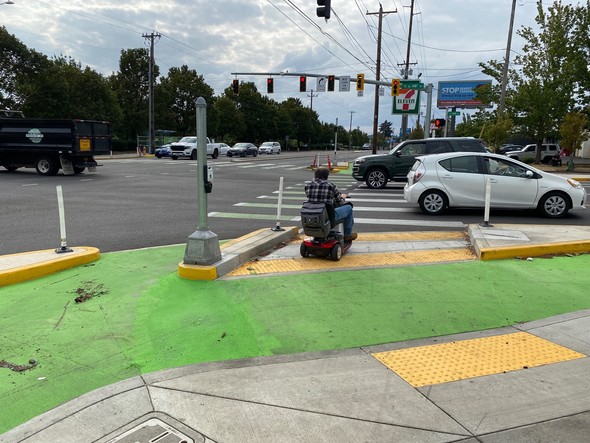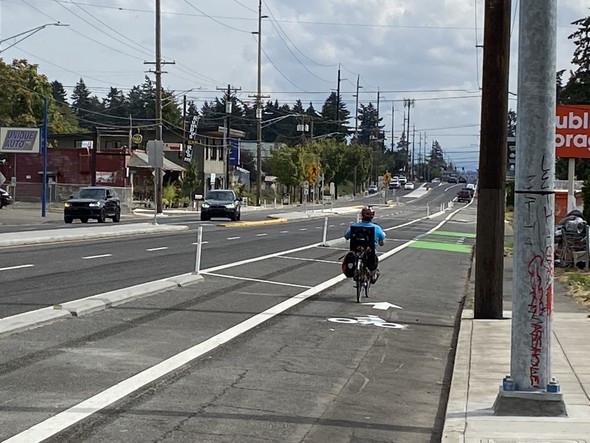 News media contact:
Dylan Rivera
503-577-7534
dylan.rivera@portlandoregon.gov
@pbotinfo
News Release:
PBOT urges the public to slow down, as speed, impairment keep pedestrian deaths at historic high level in Portland, across U.S. in 2022
The first names and approximate location of the 63 people who were killed in traffic crashes in Portland in 2022. Each death affects a community of people who knew that person, underscoring the need to improve safety on streets and highways across the city. Image by PBOT.
(March 13, 2023) The Portland Bureau of Transportation (PBOT) urges the public to slow down, as a total 63 people died in traffic crashes in 2022, matching 2021’s high of at least three decades.
Speed, impairment, and traveling on high crash corridors accounted for most traffic crashes. The 30 busy, multilane streets PBOT has identified as high crash corridors comprise less than 10% of city streets, but accounted for 70% percent of the traffic deaths last year.
The findings were published today in the bureau's annual report on traffic deaths, the Portland 2022 Deadly Traffic Crash Report. The high number of deaths in 2022 corresponds with a national trend of a steep increase in fatalities during the pandemic, driven by excessive speed, as well as reckless and impaired driving.

City Commissioner Mingus Mapps, who oversees PBOT, said the report should be a stark reminder to everyone to slow down and use caution.
"No one should be killed just by traveling on the streets of Portland, no matter how they travel," Mapps said. "I urge everyone to think of this report as call for us to drive carefully, to never drive while impaired and to always follow the speed limits and other rules of the road. As transportation commissioner, I will do everything I can to prevent traffic deaths, including investing in safety improvements on Portland’s high crash corridors and exploring an increased role for enforcement."
Tara Wasiak, Interim Director of PBOT, said the bureau is committed to the Vision Zero goal of eliminating traffic deaths and serious injuries.
"A Vision Zero approach shows us that every traffic death is preventable, with the right combination of street design, slower speeds, and shared responsibility among everyone in our community," Wasiak said. "Even though the pandemic changed travel patterns and transportation funding in ways no one could have foreseen, PBOT remains steadfast in our commitment to do everything we can to prevent traffic deaths."
The annual traffic crash report provides a snapshot of traffic deaths and serious injuries for one year, based on preliminary data from reports by the Portland Police Bureau. Final figures will be forthcoming from the Oregon Department of Transportation in 2024.
It takes years for trends to emerge, but the data available for 2022 appear to point to several patterns:
|
-
Pedestrians: In the last two years, there has been a dramatic increase in the number of pedestrians who died compared with the three years prior. There was an average 16 pedestrians who died each year in 2018-2020, compared to 27 in 2021 and 28 in 2022.
-
Speed limits: Portland has aggressively reduced speed limits the last five years. While only 8% of city streets and state highways in Portland remain posted at 35 mph or higher, 46% of traffic deaths occurred on these streets in 2022. The high number of traffic deaths on these streets underscores the need to build safety improvements and reduce posted speeds.
-
Darker conditions: Seventy-four percent of traffic deaths occurred in darker conditions, which includes dusk, nighttime, and dawn, with a three-year average of 72%. Of pedestrian deaths, 93% occurred in darker conditions, with a three-year average of 89%.
-
Hit and run crashes: Deaths from hit-and-run crashes have doubled in recent years. Seventeen people died in hit-and-run crashes in 2022, compared with 14 in 2021 and seven in 2020. Driving impaired is often a reason for hit-and-run crashes.
 |
A person uses a mobility device to safely wait for the traffic signal to change at a protected intersection on SE Division Street at 148th Avenue September 2022. PBOT works with regional partners such as TriMet, which built this as part of the Division Transit Project, to make safety improvements like shorter pedestrian crossings and protected bike lanes and intersections, which can reduce the rate of fatal crashes and reduce the severity of traffic crashes. Photo by PBOT.
Traffic deaths by year in Portland
This chart from the Portland 2022 Deadly Traffic Crash Report shows the number of traffic deaths by year in the City of Portland, with figures for each mode of transportation.
In addition to these patterns, the report notes the number of traffic deaths involving people in a variety of other circumstances.
Houseless community members made up 19% of traffic deaths in 2022, while they comprise less than 1% of the total population in Multnomah County. Of the 28 pedestrians who died in 2022, 10 of them (36%) were experiencing houselessness, meaning that Portlanders experiencing houselessness were over 50 times more likely to die as a pedestrian in a traffic crash than the population overall.
PBOT first started tracking traffic deaths involving houseless community members in 2021 when we found that 33% of all traffic deaths and 70% of pedestrian traffic deaths were people experiencing houselessness. The staggeringly disproportionate impact of traffic violence on this population speaks to the extreme risks of persistent exposure to traffic, often on high-speed streets.
Despite the high number of deaths, the City of Portland's Vision Zero efforts, led by PBOT show signs of progress in making the kinds of improvements that national studies show will make our streets safer:
-
Projects show progress: In the past four years, PBOT has added significant safety design features on about a dozen high crash corridors. Evaluation reports for some of the projects show that they have reduced top-end speeding (more than 10 mph over the speed limit) by 67% to 81%.
-
In 2022: The East Glisan Street update, phase 2, installed a street reconfiguration that added protected bike lanes from NE 102nd to 122nd avenues, and two new pedestrian crossings. Also in 2022, the Outer Division Safety Project added ten crossings, protected bike lanes and center medians from NE 80th to 174th avenues and the SW Broadway bike improvement project added protected bike lanes.
-
In 2023: Safer street designs are expected to be completed on SW Fourth Avenue downtown, on SW Capitol Highway, on the SE Foster-Woodstock couplet, and on NE Halsey Street.
-
Federal support: Portland's leadership as a Vision Zero city since 2015 helped it recently win a $20 million grant from the U.S. Department of Transportation to fund safety improvements on a critical 5.5-mile stretch of SE 122nd Avenue, a high crash corridor that contributes to a high rate of crashes in East Portland.
 |
A person rides a bike on SE Division Street at 104th Avenue on a new protected bike lane, with sidewalks and a median island that were built by PBOT's Outer Division Safety Project. The project redesigned the street with proven safety measures that will reduce the number and severity of crashes on SE Division Street, which has been one of the deadliest high crash corridors in Portland over the last decade. Photo by PBOT.
###
The Portland Bureau of Transportation (PBOT) is the steward of the City’s transportation system, and a community partner in shaping a livable city. We plan, build, manage and maintain an effective and safe transportation system that provides access and mobility. Learn more at portland.gov/transportation
|